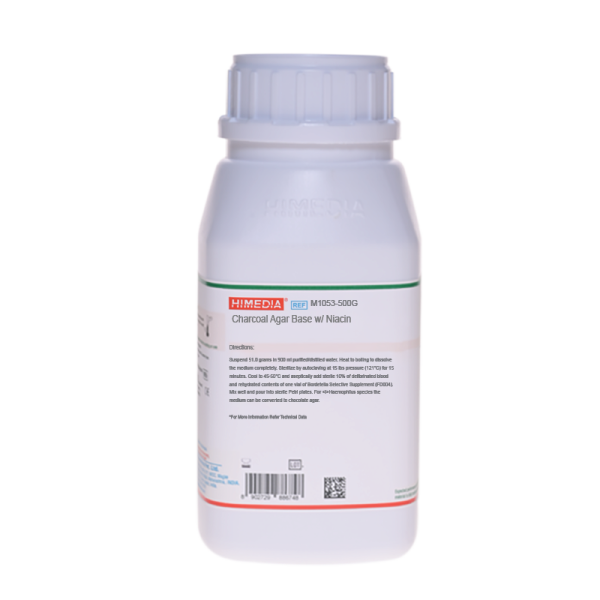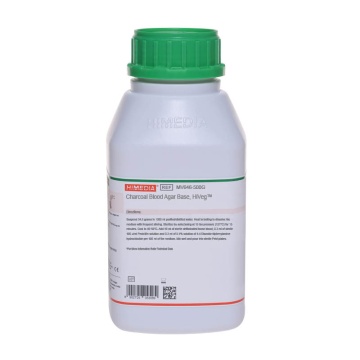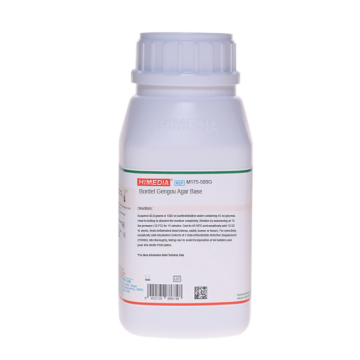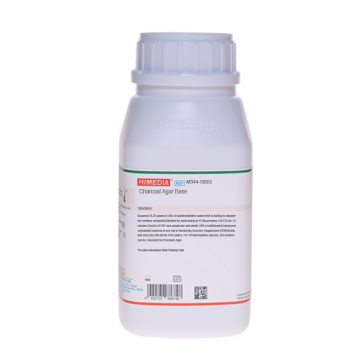 Your enquiry has been submitted
Your enquiry has been submitted
Charcoal Agar Base w/ Niacin
Bordetella#CC293D
Intended Use
Recommended for cultivation of Bordetella pertussis and Haemophilus influenzae.
Composition**
| Ingredients | g/L |
|---|---|
| Gelatin peptone | 10.000 |
| HM peptone B # | 10.000 |
| Sodium chloride | 5.000 |
| Starch, soluble | 10.000 |
| Nicotinic acid (Niacin) | 0.001 |
| Charcoal | 4.000 |
| Agar | 12.000 |
Final pH (at 25°C): 7.4±0.2
**Formula adjusted, standardized to suit performance parameters
# - Equivalent to Beef extract
Directions
Suspend 51.0 grams in 900 ml purified/distilled water. Heat to boiling to dissolve the medium completely. Sterilize by autoclaving at 15 lbs pressure (121°C) for 15 minutes. Cool to 45-50°C and aseptically add sterile 10% of defibrinated blood and rehydrated contents of one vial of Bos Selective Supplement (FD004). Mix well and pour into sterile Petri plates. For Haemophilus species the medium can be converted to chocolate agar.
Principle And Interpretation
The genus Bordetella contains four species: Bordetella pertussis, Bordetella parapertussis, Bordetella bronchiseptica and Bordetella avium (1). Genetic studies have shown that these organisms are very closely related to each other. Humans are the only host of B.pertussis and B.parapertussis, while B.bronchiseptica is found in a wide variety of animals and occasionally found in humans (2). B. avium is found in birds. Bordetella species are obligately aerobic and metabolically not very active. They are non-motile except B.bronchiseptica. B.pertussis is the major cause of whooping cough or pertussis. B.parapertussis is associated with a milder form of the disease (3). Primary isolation of B.pertussis in particular, requires the addition of charcoal, 15-20% blood to neutralize the growth-inhibiting effects. Isolation of this organism requires enrichment medium. Charcoal Agar is prepared according to the method of Mishulow, Sharpe and Cohen (2). This medium can be used as a replacement for Bordet-Gengou Agar for isolation of B.pertussis and for the production of B.pertussis vaccines. Charcoal Agar supplemented with horse blood can also be used for the cultivation and isolation of Haemophilus influenzae (4). Medium ingredients like gelatin peptone and HM peptone B provide nitrogen and carbon compounds, long chain amino acids and other essential nutrients to the organisms. Sodium chloride maintains osmotic balance. Starch soluble and charcoal neutralizes substances toxic to Bordetella species such as fatty acids. Charcoal has the tendency to settle at the bottom of the flask. Therefore, before dispensing, swirl the flasks gently to obtain a uniform charcoal suspension (5). The difficulty in the isolation of Bordetella pertussis from nasopharyngeal secretions is the repression of unwanted flora during the long incubation period on nutritious media. Penicillin can be added to the medium as an antimicrobial agent for restricting the other contaminants. However Penicillin resistant flora still causes the contamination that was observed by Lacey (4). Necessity of the Nicotinic acid as a growth factor was showed by Proom (6). Methicillin was found to be superior to Penicillin in suppressing unwanted nasopharyngeal flora as observed by Broome et al (7). Sutcliffe and Abbott found that Cephalexin was still better than Methicillin (8). The medium can also be used for the maintenance of stock cultures of Bordetella pertussis on slants with weekly subcultures. Charcoal Agar with Niacin can be converted to Chocolate Agar for isolation of Haemophilus species.
Type of specimen
Clinical samples: Sputum, cerebrospinal fluid
Specimen Collection and Handling
For clinical samples follow appropriate techniques for handling specimens as per established guidelines (9,10). After use, contaminated materials must be sterilized by autoclaving before discarding.
Warning and Precautions
In Vitro diagnostic use only. For professional use only. Read the label before opening the container. Wear protective gloves/protective clothing/eye protection/face protection. Follow good microbiological lab practices while handling specimens and culture. Standard precautions as per established guidelines should be followed while handling clinical specimens. Safety guidelines may be referred in individual safety data sheets.
Limitations
- 1. Some Haemophilus species will grow on Bordetella isolation media and cross-react with B. pertussis antisera.
- 2. B. pertussis colonies may not be visible without the aid of a microscope after 2-4 days.
Performance and Evaluation
Performance of the medium is expected when used as per the direction on the label within the expiry period when stored at recommended temperature.
Quality Control
Appearance: Grey to greyish black homogeneous free flowing powder
Gelling: Firm, comparable with 1.2% Agar gel
Colour and Clarity of prepared medium: Black coloured, opaque gel with undissolved black particles forms in Petri plates
Reaction: Reaction of 5.1% w/v aqueous solution at 25°C. pH: 7.4±0.2
pH: 7.20-7.60
Cultural Response
Cultural characteristics observed with added sterile defibrinated blood and Bos Selective Supplement (FD004), after an incubation at 35-37°C for 24 - 48 hours.
| Organism | Inoculum (CFU) | Growth | Recovery |
|---|---|---|---|
| Bordetella bronchiseptica ATCC 4617 | 50-100 | good-luxuriant | >=50% |
| Bordetella parapertussis ATCC 15311 | 50-100 | good-luxuriant | >=50% |
| Bordetella pertussis ATCC 8467 | 50-100 | good-luxuriant | >=50% |
| Staphylococcus aureus subsp. aureus ATCC 25923 (00034*) | >=10⁴ | inhibited | 0% |
| Klebsiella pneumoniae ATCC 13883 (00097*) | >=10⁴ | inhibited | 0% |
Key: (*) Corresponding WDCM numbers.
Storage and Shelf Life
Store between 10-30°C in a tightly closed container and the prepared medium at 2-8°C. Use before expiry date on the label. On opening, product should be properly stored dry, after tightly capping the bottle in order to prevent lump formation due to the hygroscopic nature of the product. Improper storage of the product may lead to lump formation. Store in dry ventilated area protected from extremes of temperature and sources of ignition Seal the container tightly after use. Product performance is best if used within stated expiry period.
Disposal
User must ensure safe disposal by autoclaving and/or incineration of used or unusable preparations of this product. Follow established laboratory procedures in disposing of infectious materials and material that comes into contact with clinical sample must be decontaminated and disposed of in accordance with current laboratory techniques (9,10).
Reference
- Murray P. R., Baron J. H., Pfaller M. A., Jorgensen J. H. and YolkenR. H., (Ed.), 2003, Manual of Clinical Microbiology, 8th Ed., American Society for Microbiology, Washington, D.C.
- Mishulow, Sharpe and Cohen, 1953, Am. J. Public Health, 43:1466
- Linneman and Pery, 1977, Am. J. Dis. Child., 131:560.
- Lacey B. W., 1954, J. Hyg., 59:273.
- MacFaddin J. F., 1985, Media for Isolation-Cultivation-Identification -Maintenance of Medical Bacteria, Vol. I, Williams and Wilkins, Baltimore.
- Proom H., 1955, J. Gen. Microbiol., 12 (1): 63-75.
- Broome C. V., Fraser D. W. and English J. W., 1979, Internat. Symp. on Pertussis DHEW J., Washington D.C., pp 19-29.
- Sutcliffe E. M. and Abbott J. D., 1979, B.M.J. II: 732-733.
- Isenberg, H.D. Clinical Microbiology Procedures Handbook 2nd Edition.
- Jorgensen, J.H., Pfaller, M.A., Carroll, K.C., Funke, G., Landry, M.L., Richter, S.S and Warnock., D.W. (2015) Manual of Clinical Microbiology, 11th Edition. Vol. 1.
| Product Name | Charcoal Agar Base w/ Niacin |
|---|---|
| SKU | M1053 |
| Product Type | Regular |
| Physical Form | Powder |
| Origin | Animal |
| Packaging type | HDPE |
| References | 1. Murray P. R., Baron J. H., Pfaller M. A., Jorgensen J. H. and YolkenR. H., (Ed.), 2003, Manual of Clinical Microbiology,8th Ed., American Society for Microbiology, Washington, D.C. |
| Customized Product Available | No |










